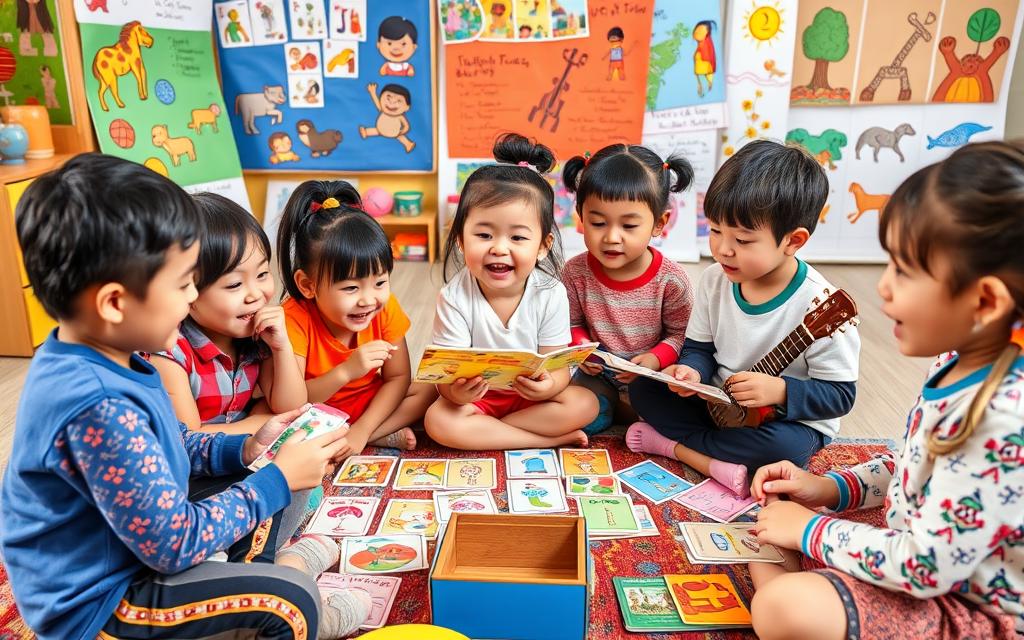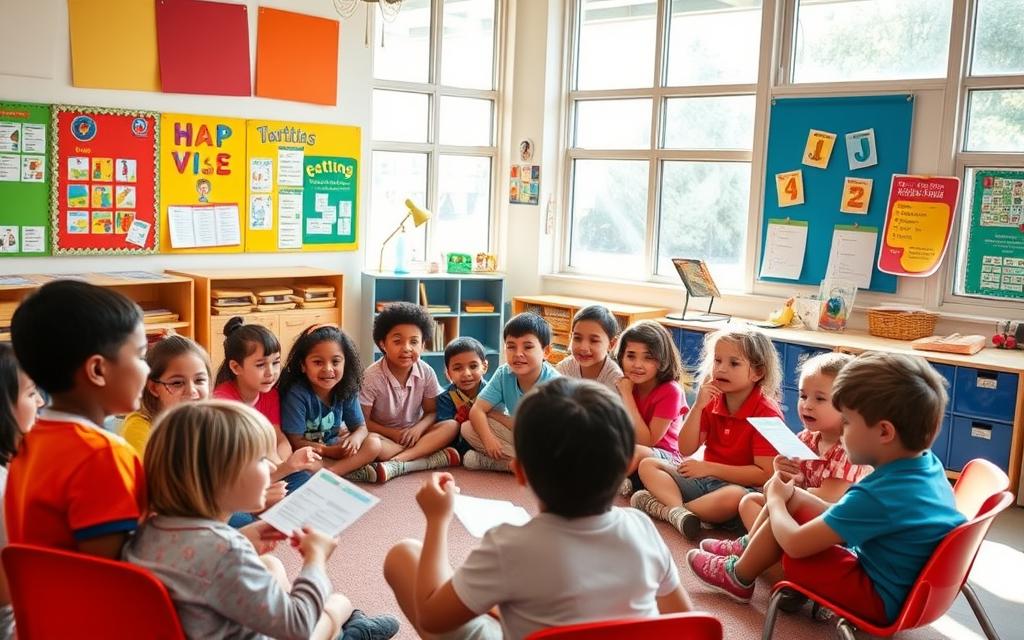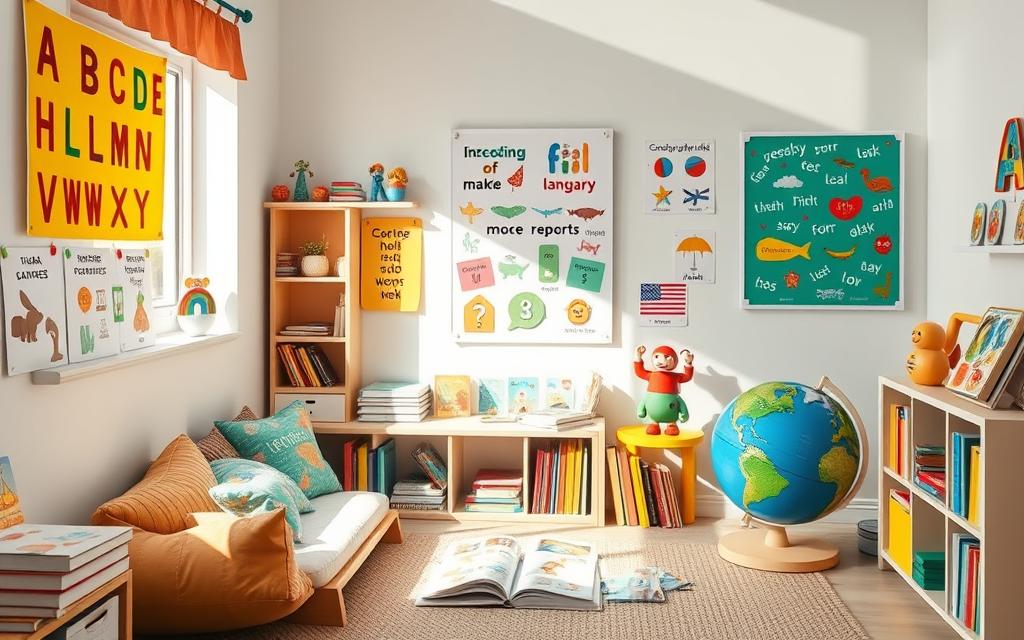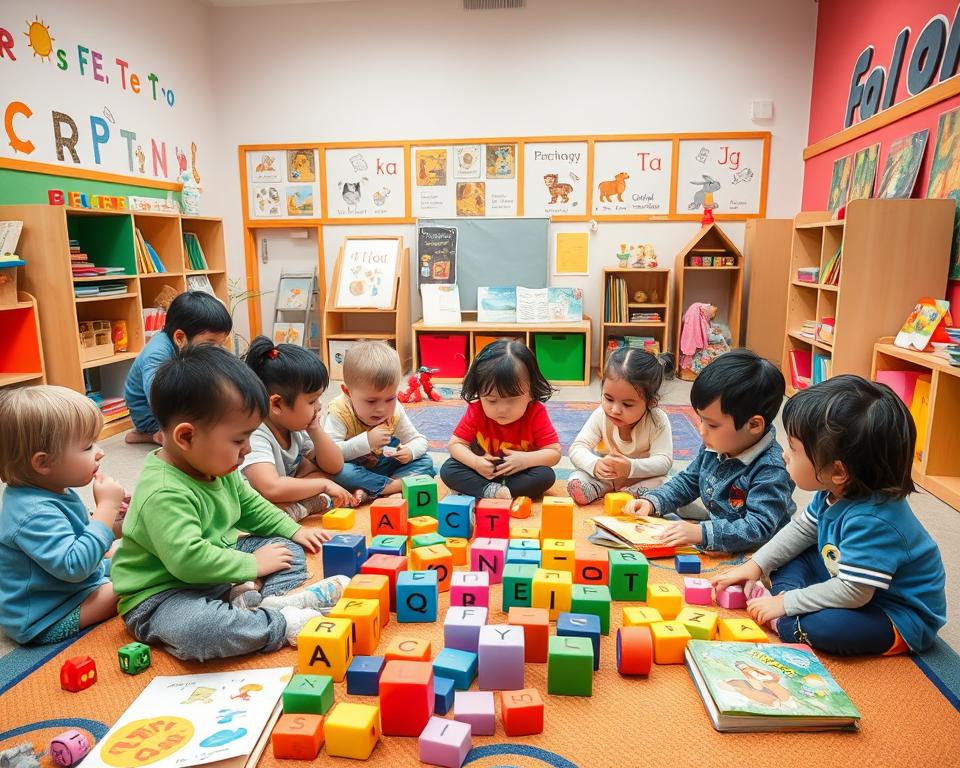Did you know that kids with strong language skills do better in school? Studies show that learning a language daily can really help a child’s school and social life. In fact, routines help kids think, reason, and plan better. Check out the tips for daily language learning routine for kids that you can use.
Having a daily routine for learning a language is key for a child’s growth and happiness. Routines give kids structure and help them learn better. By doing language activities every day, kids can get better at speaking and feel more confident.
The Importance of Language Learning Routines
Creating a regular routine for kids to learn languages is key for their growth and school success. Routines make kids feel safe and know what’s coming. This helps them handle changes better and become more independent.
Language learning routines are full of benefits for kids. They help kids practice skills like understanding time and planning. Kids also learn important language and concepts, like big and little, through these routines.
- Engaging in familiar activities helps kids build friendships and feel confident.
- Stable environments and positive interactions with adults are vital for kids’ social and emotional growth.
- Keeping routines consistent helps provide a stable home life for kids.
Setting up a daily ESL routine for children helps create a structured learning space. Daily reviews, visual aids, and positive feedback can boost kids’ language skills.
“Children learn language and concepts through everyday routines, where they hear words repeatedly in the same situation, making it easier for them to learn due to repetition and familiarity.”
Adding language-rich activities to daily routines, like mealtime and bath time, can improve kids’ speaking and vocabulary. By making language learning a regular and fun part of their day, kids can excel in their language learning schedule and succeed in school and socially.

Create an Effective Morning Language Practice Schedule
Starting the day with language learning is great for kids. It helps them build a strong base in their new language. Using tablets can make learning flexible and fun, with lots of resources at their fingertips.
Keeping motivated is key. Having materials ready, like on a nightstand or phone, makes it easy to practice anytime. This way, their language learning schedule for children fits right into their day.
- Dedicate a consistent 30-60 minute morning slot for language practice.
- Utilize digital tools like tablets for course materials and audio resources.
- Keep learning materials within easy reach to maximize opportunities for practice.
- Nurture internal motivation through goal-setting and progress tracking.
- Incorporate a variety of activities, such as vocabulary building, conversational practice, and grammar exercises.
“Consistency is the key to effective language learning, especially for young minds. Developing a structured morning routine can significantly enhance fluency and confidence.”
Creating a solid, effective morning language practice schedule helps kids learn their new language well. It also makes them feel secure and motivated. This way, they get the most out of their daily language practice.

Daily Language Learning Routine for Kids: Step-by-Step Guide
Creating a daily routine for kids to learn a new language is key. It helps them develop strong language skills. This routine offers chances for interactive language practice for children. It also boosts vocabulary, understanding of language patterns, and overall language skills.
Here’s a simple guide to setting up a daily language learning routine for young learners:
- Start with greetings: Begin the day by practicing simple greetings like “Good morning” or “Hello” in the target language. Ask your child to respond.
- Alphabet and number practice: Spend a few minutes on the alphabet and counting numbers in the target language. Use flashcards, games, or sing the alphabet song to keep it fun.
- Color and shape recognition: Teach colors and shapes and have your child identify and name them in the target language. This builds vocabulary and visual skills.
- Months and days recitation: Recite the days of the week and months of the year in the target language. This repetition helps remember these important language elements.
- Calendar activities: Talk about the current date, day, and weather in the target language. Encourage your child to join in this daily activity.
- Storybook reading: Make time for reading children’s books in the target language. Stop to ask questions and have your child guess what happens next.
- Interactive games: Add fun, language-focused games like “Simon Says” or “I Spy” to practice listening, speaking, and following instructions.
By adding these activities to a daily language learning routine for kids, you give your child regular exposure to the target language. This supports their language growth and makes learning fun and effective.

“Consistent engagement in daily activities aids children in understanding and using language effectively.”
Interactive Tools and Materials for Language Learning
Adding interactive elements to your child’s language learning can make it more fun and effective. There are many tools and materials that support interactive language practice for children and vocabulary building exercises.
Monthly calendars, weather charts, and daily schedules are great options. You can buy them or make them with poster paper, index cards, and Velcro. Laminating these materials keeps them in good shape for a long time, so your child can use them over and over.
For instance, a set of 54 themed storytelling cards can be very engaging. These cards, in 9 categories like “Going to the Store” and “Bedtime Routine,” are 4.5 x 4.5 inches. They have big, clear pictures to help with language skills.
These cards help with speech, social skills, and understanding stories. They also help remember new words and understand them better because of the pictures.
“The cards support critical thinking skills like inference, prediction, and understanding cause and effect through the storytelling scenarios, and encourage social-emotional learning by facilitating discussions on feelings and interactions depicted on the cards.”
Using dry erase markers on laminated materials is another fun way to learn. It lets kids highlight, annotate, and interact with the content. This makes their language skills even stronger.
By using these interactive tools and materials every day, you can make learning fun and engaging. It helps your child learn and grow their language skills.

Incorporate Technology in Language Learning Activities
Technology is now a key part of learning languages for kids. Devices like tablets and smartphones make it easy to find lots of fun language learning stuff. This includes PDFs, MP3s, apps, and podcasts. By adding these interactive language practice for children to a daily ESL routine for children, learning becomes more exciting.
One good idea is to pick a Twitter feed full of language-related content. Kids can look at it during free time, improving their reading and understanding. Online learning sites also have games and activities that fit into daily routines. This keeps kids interested and eager to learn.
“Technology facilitates a wider exposure to the target language and cultural contexts for language learners, both in and out of the classroom.”
Also, learning software that changes lessons based on how well a student does is very helpful. It makes learning more personal and effective. This helps kids get better at speaking, listening, reading, and writing.
Using technology, parents and teachers can make learning fun and engaging. This daily ESL routine for children supports their language skills in a fun way.

Build Vocabulary Through Daily Activities
Everyday routines are full of chances for vocabulary building exercises and language immersion activities. Parents and caregivers can talk with kids during simple tasks like bath time or getting dressed. They can describe things and actions as they do these tasks.
Using words like “first,” “then,” and “at the end” helps kids understand order. It also boosts their language skills. Talking about daily routines or chores helps kids think better and learn more about language.
- Learning new words in context is key for kids’ language growth.
- Reading aloud is great for building vocabulary, good for kids of all ages.
- Doing interactive activities with new words helps kids understand them better.
Educational apps like Reading.com, backed by the science of reading, introduce new vocabulary in a structured way to improve kids’ knowledge.
- Playing games like “I Spy” and “20 Questions” can be fun ways to learn new words.
- Turning tasks like grocery shopping and cooking into lessons is a practical way for kids to learn.
- Rhyming and wordplay activities help kids develop phonemic awareness, important for reading and learning new words.
“Vocabulary growth takes time and repeated exposure to words. Reading aloud daily is the best way to enhance vocabulary.”
By adding language immersion activities to daily routines, parents and caregivers can create a language-rich environment. This supports kids’ vocabulary growth and language skills.

Make Language Learning Fun with Games and Songs
Adding games and songs to language learning makes it fun for kids. It turns their learning into an exciting adventure. This way, they start to love learning new languages.
Begin with songs like the Alphabet Song and counting tunes. These help kids remember letters and numbers. Then, play games that make them search for things around the house or on posters. These activities keep kids involved and learning.
- Incorporate seasonal songs and holiday-themed activities to add variety to the routine
- Use bilingual scavenger hunts to encourage exploration and conversation in the target language
- Engage children’s senses by pairing language learning with hands-on crafts or cooking projects
“Transforming daily activities into language learning opportunities makes the process more interactive and rewarding for children.”
Make learning a new language fun and engaging for kids. Aim for 15 minutes of practice every day. This helps build a strong foundation in the new language.

Develop Speaking and Listening Skills
Learning to speak and listen is key for kids. They can practice these skills every day through pronunciation drills and conversational practice.
When kids talk face-to-face, they learn to connect and understand more. They can say hello and ask about someone’s day. This helps them talk better and have real conversations.
Listening is also important. Kids can practice by following directions or answering questions. This makes them better listeners and helps them understand what they hear.
- Games like “Hurrah-Boo!” make kids listen well and react fast. It improves their skills.
- “Telephone Game” tests how well a message is passed on. It challenges kids’ listening and talking.
- “Thumbs Up, Thumbs Down” helps kids decide if something is true or false. It boosts their listening and understanding.
Games like “Color Me Carefully” mix speaking and listening. They help kids work together and communicate better.
“Every teacher knows that learning listening and speaking skills is crucial in the early years of elementary school.”
By adding pronunciation drills and conversational practice to daily activities, teachers can help kids improve their speaking and listening. This sets them up for success in school and life.

Track Progress and Maintain Motivation
Keeping up with a daily language learning routine is crucial for kids. It’s important to set clear goals and track progress regularly. Using charts or digital tools helps record activities, celebrate small wins, and increase task complexity.
Language trackers are great for keeping kids motivated, especially those learning alone. Tools like notebooks, calendars, and apps can help. Even bullet journals or Excel spreadsheets can be useful. Apps like Habitica make learning fun and help build habits.
- Track study time, progress, and skills in daily language learning using different tracking tools.
- Assess proficiency levels to set appropriate language learning goals.
- Maintain a list of learned words to track vocabulary acquisition.
- Regularly review progress, track study time daily, and set specific language learning goals.
Remember, kids can only focus for 15-20 minutes at a time. Make learning fun with flashcards, apps, and interactive media. This keeps them excited about learning a new language.
“Regularly doing exercises on an English learning app is a good habit.” – Language Learning Expert
Tracking progress and making learning fun are keys. Parents and educators can foster a love for language in kids. This ensures they stay motivated and engaged in their learning journey.

Creating a daily language learning routine for kids is very beneficial. It helps them get ready for school, improves their social skills, and boosts their brain power. By using fun activities, interactive tools, and new technologies, parents and teachers can make learning exciting for kids.
It’s important to be consistent, flexible, and make learning enjoyable. Regular practice and exposure to the language are key. Mixing structured and spontaneous activities helps kids get better over time. Setting goals, tracking progress, and praising them keeps them motivated.
Learning a second language or becoming multilingual provides numerous opportunities for children. A good daily routine, combined with the latest learning tools, helps them become confident and skilled communicators. This prepares them to succeed in our global world.
Daily Language Learning Routine for Early Childhood (0-3 Years)
Establishing a daily language learning routine for young children sets the foundation for effective communication and cognitive development. Here’s a suggested routine tailored for children aged 0–3 years:
Morning: Setting the Tone for the Day
- Morning Greetings and Conversation (5–10 minutes)
- Start the day with simple greetings in the target language.
- Example: “Good morning! How did you sleep?” in the target language.
- Use gestures and facial expressions to reinforce meaning.
- Songs and Nursery Rhymes (10 minutes)
- Sing simple songs or play nursery rhymes in the target language.
- Use hand motions or props to engage the child.
- Interactive Vocabulary Practice (5–10 minutes)
- Name objects during routine activities (e.g., “Here’s your spoon,” “Let’s put on your shoes”).
- Focus on high-frequency words related to their environment.
Mid-Morning: Play-Based Learning
- Story Time with Picture Books (10–15 minutes)
- Read age-appropriate books in the target language.
- Point to pictures and name objects or actions. Encourage the child to mimic sounds or words.
- Sensory Play with Language (15–20 minutes)
- Use toys, blocks, or textured materials and describe actions: “Stack the red block,” “Feel the soft ball.”
- Incorporate simple instructions: “Give me the yellow car.”
- Interactive Games (10 minutes)
- Play peek-a-boo, hide-and-seek, or other simple games while using target language phrases.
- Example: “Where are you?” or “I see you!”
Afternoon: Building Connections
- Meal Time Language Practice (15 minutes)
- Name foods, utensils, and actions while eating: “This is a banana,” “Take a bite.”
- Practice simple phrases like “More, please,” “Thank you,” or “All done.”
- Outdoor Exploration (20–30 minutes)
- Narrate outdoor activities: “Look at the bird,” “The tree is tall.”
- Introduce new vocabulary for nature and surroundings.
- Movement-Based Learning (15 minutes)
- Play action songs or games that combine movement and language, such as “Head, Shoulders, Knees, and Toes.”
- Use commands like “Jump,” “Run,” or “Spin” in the target language.
Evening: Winding Down
- Quiet Play with Flashcards or Visual Aids (10–15 minutes)
- Use flashcards with pictures and simple words.
- Practice identifying and repeating words together.
- Reflection and Bedtime Story (15 minutes)
- End the day with a short story in the target language.
- Talk about the day’s activities in simple sentences: “Today, we saw a bird. It was blue.”
- Lullabies or Relaxing Music (5–10 minutes)
- Play soothing music or sing a lullaby in the target language to end the day calmly.
Additional Tips
- Repetition is Key: Repeat words, phrases, and activities daily to reinforce understanding.
- Use Gestures and Expressions: Pair language with non-verbal cues to aid comprehension.
- Encourage Imitation: Celebrate any attempt by the child to mimic sounds or words.
- Keep It Fun: Make learning playful and enjoyable to hold the child’s attention.
- Consistency Matters: Practice the routine daily to establish a habit.
This routine emphasizes frequent exposure, interactive activities, and nurturing the bond between caregiver and child, making language learning a natural and joyful part of daily life.
Daily Language Learning Routine for Preschoolers (3–6 Years)
Preschoolers are at a prime age for absorbing languages through playful, interactive, and consistent exposure. Here’s a daily routine that incorporates engaging activities, vocabulary-building exercises, and plenty of opportunities for repetition and practice.
Morning: Starting the Day with Language
- Morning Greetings (5–10 minutes)
- Begin the day with simple greetings in the target language: “Good morning!” or “How are you?”
- Encourage your child to respond, even if it’s just a word or two.
- Calendar and Weather Talk (10 minutes)
- Discuss the day of the week, date, and weather in the target language.
- Example: “Today is Monday. It is sunny outside.”
- Use visuals like a weather chart or a calendar to make it interactive.
- Songs and Movement (10 minutes)
- Sing lively songs in the target language, such as the alphabet, numbers, or animal songs.
- Add actions to reinforce meaning: “Clap your hands,” “Wave hello.”
Mid-Morning: Active Learning and Play
- Story Time with Questions (15–20 minutes)
- Read books or listen to stories in the target language.
- Pause to ask simple questions: “What is this?” or “Who is in the story?”
- Let the child point, name objects, or repeat phrases.
- Art and Craft Activities (20–30 minutes)
- Provide simple art activities and describe actions in the target language: “Cut the paper,” “Draw a circle.”
- Introduce new vocabulary related to colors, shapes, or tools.
- Interactive Vocabulary Games (15 minutes)
- Play games like “I Spy” or “Simon Says” in the target language.
- Example: “I spy something red,” or “Simon says jump.”
Afternoon: Hands-On Learning
- Meal Time Vocabulary (15–20 minutes)
- Name foods, utensils, and mealtime actions in the target language: “This is rice,” or “Pass the cup.”
- Teach polite expressions like “Please” and “Thank you.”
- Outdoor Exploration (30 minutes)
- Narrate what you see while outside: “The bird is flying,” “The flower is yellow.”
- Play a scavenger hunt game by naming objects to find in the target language.
- Role-Playing and Pretend Play (20 minutes)
- Act out everyday scenarios, like shopping, cooking, or visiting a doctor, in the target language.
- Use simple dialogues: “I’d like some apples, please,” or “Hello, how can I help you?”
Evening: Review and Wind Down
- Review and Practice (15 minutes)
- Go over new words or phrases learned during the day.
- Use flashcards or point to objects and ask the child to name them.
- Bedtime Story in the Target Language (15 minutes)
- Read a short, engaging story in the target language.
- Encourage the child to repeat words or phrases after you.
- Lullabies or Relaxing Songs (5–10 minutes)
- End the day with a soothing song in the target language.
- Sing together or listen to soft music to reinforce exposure.
Weekly Additions
- Language Videos (15–20 minutes a few times a week): Use age-appropriate videos or apps to reinforce vocabulary and phrases.
- Cultural Activities: Introduce cultural songs, dances, or food to connect the language with its culture.
Additional Tips
- Repetition Builds Confidence: Repeat key phrases and activities daily.
- Incorporate Interests: Tailor activities to your child’s favorite themes (animals, vehicles, etc.).
- Celebrate Progress: Praise and encourage attempts to speak or understand the target language.
- Create a Language-Rich Environment: Label objects, display words, or play audio in the target language throughout the day.
This routine ensures a balance of structured learning and playful interaction, helping preschoolers develop language skills naturally and enthusiastically.
Daily Language Learning Routine for Primary School Age (6–10 Years)
At the primary school age, children can focus for longer periods and are ready to engage in more structured and interactive language learning activities. Here’s a comprehensive daily routine to foster their language skills while keeping learning fun and effective.
Morning: Start the Day with Language
- Morning Conversation (10 minutes)
- Greet and chat with your child in the target language: “Good morning! How did you sleep?”
- Encourage responses in full sentences, providing prompts if needed: “I slept well!”
- Daily Calendar and Routine Check (10–15 minutes)
- Discuss the day’s schedule, date, and weather in the target language.
- Example: “Today is Wednesday. It is sunny. What will we do first?”
- Use a visual calendar or weather chart for engagement.
- Morning Song or Chant (5–10 minutes)
- Sing a lively song or recite a chant in the target language.
- Choose topics like days of the week, numbers, or daily activities.
Mid-Morning: Active and Structured Learning
- Story Reading and Discussion (20 minutes)
- Read a short story or chapter book in the target language.
- Ask questions about the story: “Who is the main character?” “What happens next?”
- Let your child retell parts of the story in their own words.
- Grammar and Vocabulary Practice (15–20 minutes)
- Focus on one grammar rule or vocabulary theme (e.g., colors, animals, actions).
- Practice with fill-in-the-blank sentences, matching games, or flashcards.
- Interactive Game Time (15 minutes)
- Play language-focused games like bingo, Pictionary, or word searches.
- Use apps or online resources to make learning interactive and fun.
Afternoon: Immersive Learning
- Cooking or Crafting Activity (30–40 minutes)
- Involve your child in cooking or crafting while using the target language.
- Example: “Mix the flour,” “Cut the paper into a square.”
- Teach related vocabulary and phrases naturally during the activity.
- Outdoor Exploration (30 minutes)
- Take a walk or play outside while practicing the target language.
- Name plants, animals, or objects: “Look at the tall tree,” “Can you find a red flower?”
- Encourage your child to describe what they see.
- Dialogues and Role-Playing (15–20 minutes)
- Role-play scenarios like shopping, ordering food, or meeting a friend.
- Practice short conversations: “Hello, can I buy apples?” “How many?”
Evening: Review and Wind Down
- Homework or Workbook Practice (20–30 minutes)
- Complete worksheets, exercises, or workbook activities in the target language.
- Focus on spelling, sentence construction, or comprehension skills.
- Review and Quiz (15 minutes)
- Go over new words and phrases learned during the day.
- Create a mini-quiz or play trivia games to test knowledge.
- Bedtime Story or Song (15 minutes)
- Read a bedtime story or sing a relaxing song in the target language.
- Use this time to reinforce listening and comprehension skills.
Weekly Additions
- Cultural Exploration (Once or Twice a Week)
- Watch a cartoon, movie, or listen to music in the target language.
- Cook a dish, learn a dance, or celebrate a tradition from the language’s culture.
- Language Journal (Daily or Weekly)
- Have your child write or draw something they learned each day in a journal.
- Example: “Today I learned: cat = gato” or draw a picture of a cat.
Additional Tips
- Consistency is Key: Make language learning a regular part of your daily routine.
- Celebrate Effort and Progress: Praise your child for trying and improving, even if mistakes are made.
- Keep It Fun: Incorporate games, songs, and activities to maintain enthusiasm.
- Set Goals: Work on achievable goals, such as learning 5 new words a day or holding a short conversation by the end of the week.
This routine ensures a well-rounded approach, balancing structured learning with playful and immersive activities to help primary school children develop language skills effectively.
Daily Language Learning Routine for Adolescence (10+ Years)
Adolescents are more capable of self-directed learning, critical thinking, and applying language skills in meaningful contexts. A daily routine for this age group should balance structured practice with opportunities for creativity and immersion in the target language.
Morning: Setting the Tone
- Morning Review and Goal Setting (10–15 minutes)
- Review vocabulary or concepts learned the previous day.
- Set daily goals, like learning 10 new words or mastering a grammar concept.
- Listening Practice (10–15 minutes)
- Listen to a podcast, news report, or a short story in the target language.
- Jot down key points or unfamiliar words to review later.
- Quick Grammar or Vocabulary Practice (10 minutes)
- Focus on one specific grammar point or vocabulary set (e.g., verbs, adjectives, or idioms).
- Use apps, flashcards, or workbook exercises for practice.
Mid-Morning: Active Learning
- Reading and Comprehension (20–30 minutes)
- Read a book, article, or blog post in the target language.
- Summarize or answer questions about the material to check comprehension.
- Interactive Speaking Practice (15–20 minutes)
- Practice speaking through role-plays, shadowing (repeating after audio), or recording themselves speaking.
- Use prompts like describing a picture, narrating a story, or debating a topic.
- Grammar and Writing Practice (20–30 minutes)
- Focus on sentence construction or creative writing (e.g., short stories, journal entries, or letters).
- Example: Write about their favorite hobby or describe their daily routine in the target language.
Afternoon: Immersive Activities
- Cultural Exploration (30 minutes)
- Watch a movie, TV series, or YouTube video in the target language.
- Discuss or write a review afterward to integrate new vocabulary.
- Real-Life Application (15–20 minutes)
- Engage in activities like cooking using recipes in the target language, chatting with native speakers online, or playing games in the language.
- Use language exchange apps or participate in online forums.
- Vocabulary Expansion (10–15 minutes)
- Learn new words or phrases related to their interests (sports, music, hobbies).
- Use them in sentences to reinforce understanding.
Evening: Reflect and Wind Down
- Reflection and Journaling (15–20 minutes)
- Write about their day in the target language.
- Focus on incorporating new words and phrases.
- Review and Self-Quiz (10–15 minutes)
- Go over the day’s new material.
- Use flashcards, create a self-quiz, or try to teach someone else what they learned.
- Relaxing Listening or Reading (10–15 minutes)
- Listen to music, read a poem, or explore a comic in the target language for enjoyment and relaxation.
Weekly Additions
- Speaking Challenge (Once or Twice a Week)
- Have a longer conversation with a tutor, friend, or family member in the target language.
- Join a language class or participate in a group activity online.
- Cultural Immersion Activity (Once a Week)
- Explore the culture associated with the language through documentaries, virtual tours, or cultural events.
- Assessment and Goal Revision (Weekly)
- Reflect on progress, revise goals, and identify areas needing improvement.
Additional Tips
- Make It Personal: Tailor learning to their interests (e.g., learning slang from music or sports terms).
- Stay Consistent: A daily routine, even 30–60 minutes, is more effective than sporadic intensive sessions.
- Leverage Technology: Use apps, online courses, and tools like language exchange platforms for variety and motivation.
- Celebrate Success: Reward accomplishments, like completing a book, mastering a concept, or holding a conversation.
This routine provides structure while encouraging autonomy, creativity, and immersion, helping adolescents achieve fluency and confidence in their target language.
Key Takeaways
- Daily language learning routines contribute to better school performance and social interactions.
- Consistent routines help children develop executive functions and practice self-control.
- Routines provide structure, repetition, and strong relationships with adults, which are crucial for language learning.
- Language-based activities, such as reading, playing, and singing, should be incorporated into a child’s daily life.
- Establishing a daily language learning routine is essential for a child’s overall development and well-being.
Source Links
- Routines: Get Kids Ready for Language Learning and for School – https://cissnewsletter.ca/2020/08/12/routines-get-kids-ready-for-language-learning-and-for-school/
- How To Set A Language Fluency Goal For Your Child + A Plan To Reach It – https://www.theculturedkid.com/blog/how-to-set-a-language-fluency-goal-for-your-child-a-plan-to-reach-it
- The Importance of Schedules and Routines | ECLKC – https://eclkc.ohs.acf.hhs.gov/quienes-somos/articulo/importance-schedules-routines
- Using language strategies in everyday routines – https://www.goldcoast.health.qld.gov.au/our-services/childrens-services/community-child-health/talk-me/everyday-routines/using-language-strategies-everyday-routines
- PDF – https://americanenglish.state.gov/files/ae/resource_files/sept_week_2_daily_routine_final.pdf
- Language study plan: Your guide to creating the perfect language learning schedule [+ template] – https://preply.com/en/blog/language-study-planner/
- How to Practice Speech and Language with Your Child During the Morning Routine – https://www.expressable.com/learning-center/tips-and-resources/how-to-practice-speech-and-language-with-your-child-during-the-morning
- Daily Routines to Enhance Your Child’s Language Development – https://www.mywellnesshub.in/blog/daily-routines-child-language-development/
- Easy Ways to Teach Your Child a Foreign Language From 0-6 Years – https://www.theculturedkid.com/blog/nurture-language-development
- How to Learn a Language With Your Kids – https://www.pimsleur.com/blog/language-learning-with-kids/
- Sequence for Kids: Daily Routine Cards – https://thought-spot.com/product/sequence-for-kids-daily-routine-cards-speech-therapy-material/
- Best Language Learning Apps For Kids – https://testprepinsight.com/best/best-language-learning-apps-for-kids/
- Technology in language teaching and learning – https://sanako.com/technology-in-language-teaching-and-learning
- Technology and |Language Development in Early Childhood| – https://www.ictesolutions.com.au/blog/how-to-better-implement-ict-activities-for-language-development/
- 10 Fun Ways to Build Kids’ Vocabulary – Reading.com – https://www.reading.com/blog/ways-to-build-kids-vocabulary/
- Vocabulary: Activities for Your Pre-K Child – https://www.readingrockets.org/literacy-home/reading-101-guide-parents/your-pre-kindergarten-child/vocabulary-activities
- 4 Vocabulary Development Activities for Families at All Ages – https://parentpowered.com/blog/science-of-reading/vocabulary-development/
- 30 Insanely Fun Ways To Learn A Language (So You’re Never Bored) — Sololingual – https://www.sololingual.com/blog/fun-ways-to-learn-a-language
- Creating a Language Learning Routine: Tips for Busy Families – https://outdoorbilinguallearner.com/2024/09/13/creating-a-language-learning-routine-tips-for-busy-families/
- 12 Speaking and Listening Activities to Boost Your Students’ Skills – https://www.teachstarter.com/us/blog/10-activities-for-speaking-and-listening-us/
- Speaking and Listening in Content Area Learning – https://www.readingrockets.org/topics/comprehension/articles/speaking-and-listening-content-area-learning
- 17 Ways to Improve Your Students’ Oral Language Skills – Brookes Blog – https://blog.brookespublishing.com/11-ways-to-improve-your-students-oral-language-skills/
- 8 Ways to Track Your Language Learning Progress | FluentU Language Learning – https://www.fluentu.com/blog/learn/language-learning-tracker/
- New Year, new habits! Language learning routine to follow in 2023 – https://www.novakidschool.com/blog/new-year-new-habits-language-learning-routine-to-follow-in-2023/
- Jamila Musayeva – https://jamilamusayeva.com/blog/how-to-learn-multiple-languages-how-i-learned-taught-my-kids-speak-4-languages
- How to Create a Morning Routine That Boosts Speech for Kids with Language Delays – SmallTalk – Bellevue WA – https://smalltalkpediatric.com/how-to-create-a-morning-routine-that-boosts-speech-for-kids-with-language-delays/
- 13 Ways To Effortlessly Integrate Studying Into Your Language Learning Routine — Sololingual – https://www.sololingual.com/blog/language-learning-routine



